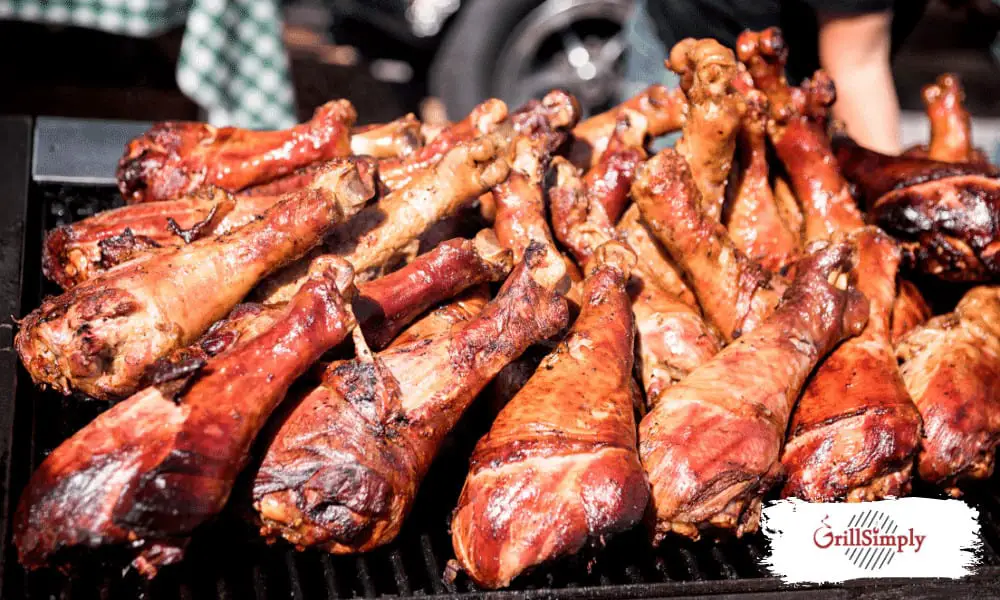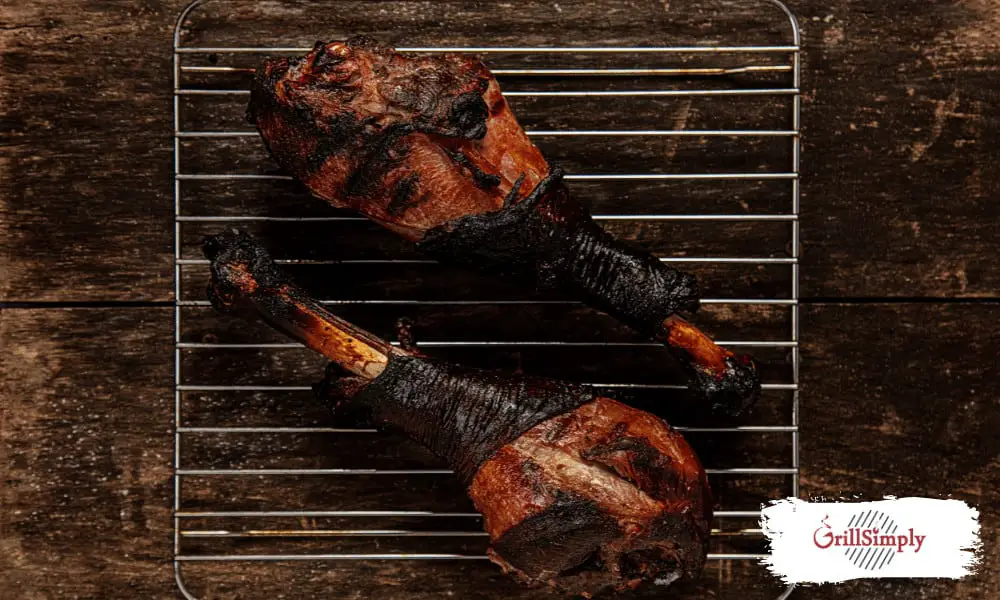There are often two sides to every story. In the book of deliciously smoked turkey, well, one side is to avoid rubbery skin and the other is to pursue crispy skin.
In hopes of getting the perfectly crispy turkey skin, you can’t skip over the chapters about avoiding rubbery skin – believe me!
Okay, enough of the book analogies.
Here we go through the crucial steps to avoid rubbery skin on smoked turkey, what you can do to get crispy skin on smoked turkey, and some other juicy tips!

A succulent smoked turkey is the stuff Thanksgiving dreams are made of – or any other excuse fit for a feast!
But, we all know that feeling. That undeniably unpleasant texture of rubbery turkey skin. Although it won’t ruin the turkey entirely, it’s a quick and easy way to disappoint your taste buds.
So why does smoked turkey skin come out rubbery anyway?
Well, as it turns out, there are a few key steps in the cooking process that should be modified when you’re smoking poultry, like turkey or chicken.
That’s because smoking at too low temperatures, wet brining, and basting can actually cause the skin to become rubbery, tough, and chewy.
Here’s what I mean.
Smoking At A Too-Low Temperature
When you’re smoking traditional barbecue meats like brisket or pork shoulder, the process of low and slow smoking helps to break down the connective tissue and fat that connects the proteins together.
But, turkey doesn’t have connective tissue at all, so this process doesn’t apply here.
If you smoke turkey at traditional 200-250°F temperatures, what you’ll find is that the fat within the skin simply won’t render, and instead, the moisture will become trapped. This leaves the turkey with a tough, rubbery, and chewy skin.
On the other hand, smoking turkey at higher temperatures will draw out the moisture in the skin, allowing the fat to properly render, completing what’s called the Maillard reaction. All while still “slow-cooking” the turkey, leaving it moist, juicy, AND with crispy skin.
The same principles apply to avoiding rubbery skin on chicken too!
Wet Brining
Wet brining is a technique used to help the turkey absorb extra moisture, keeping it juicy and tender throughout long cooks.
I’m not denying that it helps keep a turkey juicy, but wet brining does also make it much more difficult for the skin to dry out and become crispy. Instead, it retains its moisture and has a tendency to cause the skin to become tough and rubbery, especially when smoked at low temperatures.
If you’re looking for that beautiful crispy skin, wet brining your turkey means you’ll have to work extra hard to keep the turkey skin from becoming rubbery!
Basting Or Mopping
By now you can kind of tell that excess moisture and rubbery turkey skin go hand in hand. So, although it may seem like basting or mopping your turkey will help add layers or flavor and keep things moist, it definitely can cause tough rubbery skin.
Basting or mopping halts the dehydration process of the turkey skin. If it retains too much moisture the fat won’t render and crispen – leaving you with some pretty rubbery skin!
Some even go as far as to say that using a water pan can prevent crispy skin too (due to the increased moisture content in the air).
If you really want to baste or mop your turkey, it’s best to do it at the beginning of the smoke. This way there’s still plenty of time to draw out the moisture and crispen it up toward the end of the cook!
How Can You Get Crispy Skin On Smoked Turkey?

In your endeavours to get the perfect smoked turkey, avoiding all the processes that cause rubbery skin is only half the battle.
Following along with the same principles, i.e. keeping your turkey skin dry throughout the smoking process, there are a few techniques you can use to maximize the crispiness of your turkey skin – without sacrificing the moist and juicy meat!
So, to help get crispy skin on your smoked turkey you should:
- Smoke Your Turkey At Higher Temperatures (275-325F).
- Use A Dry Brining Process.
- Consider Spatchcocking/Butterflying Your Turkey.
- Crank To A High Temp For The Last 30 Minutes.
Smoke Your Turkey At Higher Temperatures
So we know that low temperatures and crispy turkey skin don’t tend to go together. But, by smoking your turkey at temperatures between 275-325°F you’ll be able to enjoy the same, juicy, tender turkey – except with crispy skin!
But smoking your turkey at higher temperatures above 275°F isn’t just good for crispy skin. It also means it’ll be done faster and usually you’ll see a much darker brown color on it too!
Believe me, try smoking your turkey between 275°F-325°F next time, and try to tell me you can’t experience the difference!
This same philosophy can be applied to smoking a precooked turkey too!
Dry Brining (Plus Baking Powder)
Dry brining is similar to wet brining, but without the water!
This solves the problem of the skin absorbing too much moisture and more easily becoming rubbery during the smoking process.
To “dry brine” simply pat the skin dry and apply a handsome amount of your favorite rub, or keep it simple with salt or herbs. The salt helps to draw moisture from the skin, making it that much easier to crispen up.
Now here’s the tip: Add a quarter of a teaspoon of baking powder to the rub! This helps the skin dry out more easily and crispen up nicely!
Spatchcock Or Butterfly Your Turkey
Butterflying (also called spatchcocking) means to remove the backbone of the bird and lie it flat.
The main reasons you would spatchcock a turkey is to maximize the surface area, allowing more smoke flavor to penetrate the meat, the skin to dry out and crispen more easily, and for a significantly faster cooking time.
Smoking a spatchcocked turkey at 275°F only takes 3-5 hours, depending on the size of the bird.
Don’t worry, if you cook it right you won’t be sacrificing juiciness or tenderness. Plus, if your turkey is done too early, you can always rest it using the “faux cambro” method for up to two hours!
Crank Up That Heat At The End!

Another technique you can use to really give your turkey a good color and crispen up the skin is to crank up the heat for the last 15-30 minutes of the cook. The can be done on the smoker, or even by finishing your smoked turkey in the oven.
If you’re smoking turkey wings or legs, you can even go ahead and through them onto a hot grill and get some nice sear marks. You’ll get an amazingly tender smoked turkey with a nice crispy, crunchy skin.
However, try not to overdo it as burning the turkey skin will cause it to become black and bitter.
The Final Chapter
Yes, the final chapter. I came back to the book, analogies.
Really, the secret to avoiding rubbery skin on smoked turkey goes hand in hand with the top tips to get a crispy skin:
- Keep that skin dry! Avoid using wet brines, marinades, or basting your turkey.
- Smoke your turkey at higher temperatures between 275-325F.
- Use a salty rub, or add baking powder to the mix to really dry out and crispen that skin up.
- Consider spatchcocking your turkey. Maximizing that surface area helps for crispier skin without sacrificing flavor or tenderness.
Smoked turkey with crispy skin? Couldn’t think of anything better.


